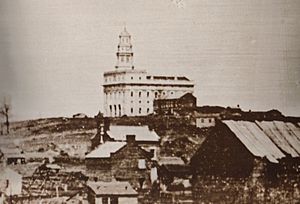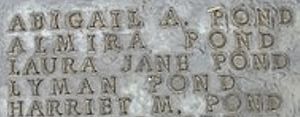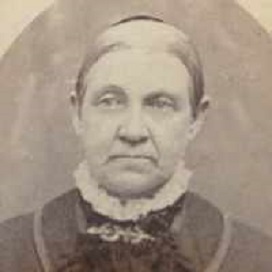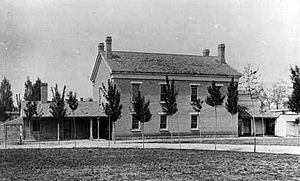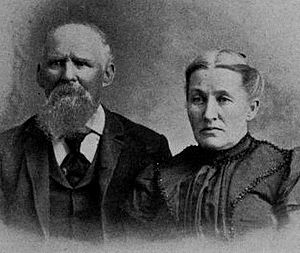Stillman Pond facts for kids
Quick facts for kids Stillman Pond |
|
|---|---|
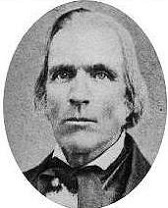 |
|
| Second Quorum of Seventy | |
| May 17, 1845 – February 16, 1853 | |
| Called by | Brigham Young |
| End reason | Honorably released because of his calling and setting apart as Senior President of the 35th Quorum of Seventy. |
| Senior President of Thirty-fifth Quorum of Seventy | |
| February 16, 1853 – September 30, 1878 | |
| Called by | Brigham Young |
| End reason | Death. |
| Personal details | |
| Born | October 26, 1803 Hubbardston, Massachusetts, United States |
| Died | September 30, 1878 (aged 74) Richmond, Utah Territory, United States |
Stillman Pond (born October 26, 1803 – died September 30, 1878) was a hardworking farmer, harnessmaker, and land investor from Hubbardston, Massachusetts. He became a brave Mormon pioneer and church leader. Stillman is remembered for the big sacrifices he made during the journey of the Latter-day Saints. This journey, called the Mormon exodus, took them from Nauvoo, Illinois, to the Salt Lake Valley in what is now Utah Territory. This amazing trek happened between September 1846 and September 1847.
Contents
Early Life in Massachusetts
Stillman Pond came from a strong family of early settlers in New England. Many of his ancestors were ministers and town leaders. He was born just two years before Joseph Smith, the prophet who founded the Latter-day Saint religion. Stillman and Joseph Smith even shared some family history.
Stillman's great-great-grandfather, Ezra Pond, was a pastor who didn't always agree with community leaders. He moved his family to Hubbardston. Stillman's great-great-grandfather on his mother's side, Lt. Paul Moore, was an American army commander in the Revolutionary War.
Stillman was a very thrifty and hardworking person from a young age. He always made sure his businesses were profitable. In 1825, he married Almyra Whittemore and moved to Westminster. He bought several pieces of land there. In 1832, they moved to Templeton. Almyra had five children with Stillman. Sadly, she died at age 33 in 1833 during a yellow fever outbreak. She was buried in Hubbardston.
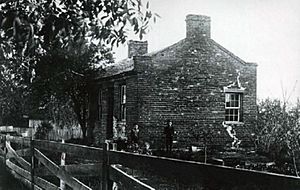
Becoming a Latter-day Saint
Stillman Pond was a young widower with five children. He would later marry four more times and have many descendants.
In 1834, Stillman married Maria Louisa Davis. They settled back in Hubbardston. In 1837, they moved to New Salem, Massachusetts, where Stillman bought more land. There, they made new friends, including the Haskell family. In 1841, Stillman and his family welcomed traveling Latter-day Saint missionaries into their home. They learned about the new faith that Joseph Smith had started. The family was baptized on December 28, 1841.
The message of the Latter-day Saints brought Stillman great comfort and peace. It offered hope for his family, both living and those who had passed away. Stillman was able to sell his land. In the fall of 1843, he and his family made a long journey across five states to Nauvoo, Illinois. They wanted to join the other Latter-day Saints who were gathering there.
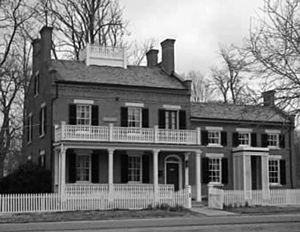
Life in Nauvoo
In Nauvoo, Stillman built a two-story red brick home. He also opened a store in the front part of his house. His home was a few blocks southwest of the Nauvoo Temple on Munson Street. It was close to the Mississippi River.
Stillman soon discovered that his neighbors were important church leaders. His home was near the homes of his friends Winslow Farr and his son Lorin Farr. It was also just east of the home of Heber C. Kimball, an Apostle and close friend of Joseph Smith. Another Apostle, Wilford Woodruff, lived on the same block.
Stillman was ordained an Elder in the church in July 1844. This was only weeks after the Prophet Joseph Smith was killed. On January 1, 1845, Stillman received a special blessing called a patriarchal blessing. Later that year, on May 17, he became a member of the church's 2nd Quorum of Seventy. He and his wife Maria also received sacred temple ordinances in the unfinished Nauvoo Temple on December 30.
The Journey West and Hardships
In the fall of 1846, Stillman's family had to leave Nauvoo. They were among the last Latter-day Saints to leave Illinois. Stillman's family, including Maria who was expecting twins, traveled with other pioneers. They faced many challenges on their way to Winter Quarters in Iowa.
During that very cold winter, they lived in tents on the Nebraska side of the Missouri River. Many people became sick. Stillman lost his beloved wife and eight children to sickness and death during this time.
After losing an infant son in Nauvoo, the Ponds lost their 9-year-old son Lowell Ansen Pond during the journey to Winter Quarters. Then, Maria's newborn twin sons also died. They were named Joseph and Hyrum, after the martyred Smith brothers. All three sons were buried in shallow graves along the Mormon Trail.
Stillman and Maria were heartbroken to lose four small children. But their sacrifices were not over. Maria, weakened by malaria, eventually died on May 17, 1847, from tuberculosis. Stillman was once again a widower and deeply grieved. He himself often came close to death. But his strong faith kept him going. On June 17, he left the Missouri River camp and continued his journey to the mountains in the West. He believed he would find a special place, a Zion, that God had prepared for His people.
New Beginnings and Church Service
Stillman's third wife was Abigail Thorn. He married her in 1849 in Salt Lake City. They would have eight more children together. Stillman had traveled to Utah with Abigail's first husband, Samuel Russell, who later left his family. Stillman had settled as a farmer west of Salt Lake City. He saw the amazing miracle of the seagulls saving their crops from locusts in 1848.
Abigail had a strong conversion to the Latter-day Saint faith as a young woman. She felt inspired to join the Saints in Nauvoo. In 1843, she received a special blessing from Hyrum Smith, Joseph Smith's brother. She was blessed with the gift of dreams and visions. Abigail also witnessed a special event in Nauvoo on August 8, 1844. Many people saw Brigham Young appear and sound like Joseph Smith. This was a sign that Brigham Young was chosen to lead the church.
Settling in Utah
In 1857, Stillman and Abigail moved south from Salt Lake to Spanish Fork. But less than three years later, in 1860, they moved again. This time they went north to Richmond in Cache Valley. This was just months before the Civil War began in the East. The Ponds lived peacefully during the war years and felt very blessed.
Stillman was able to help with sacred temple ordinances in the Endowment House in Salt Lake City. He also learned about mathematics and astronomy from Apostle Orson Pratt.
In 1852, Stillman married Elizabeth Bessac, his fourth wife, and they had one child. However, she later divorced him. Stillman remained faithful to his church duties. On February 16, 1853, he was ordained the Senior President of the 35th Quorum of Seventy. He served in this calling faithfully for the rest of his life.
Later Years and Legacy
In 1865, Stillman received another patriarchal blessing. His eldest daughter with Abigail, Mary Anner Pond, married John Buxton, an English immigrant. John became a successful businessman and they raised 12 children.
Three years later, Stillman returned to his childhood home in Hubbardston, Massachusetts, when his father passed away. He received his share of his father's estate. He then returned to Utah and invested his inheritance in the Richmond Co-op, known as the ZCMI. This investment was very successful. In his later years, Stillman traveled south to St. George. He helped haul stone for the building of the temple there.
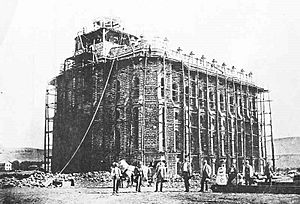
In 1870, Stillman married for the fifth and final time to Anna Regina Svensson-Jacobsen. She was a widow and had four more sons with him. Stillman passed away at age 74 on September 30, 1878, after being ill for two years. His third wife, Abigail, died 26 years later in 1904.
Stillman Pond became the ancestor of many, many descendants. They live throughout the western United States and beyond. Stillman left a powerful legacy of faith for his family. It was a legacy of sacrifice, endurance, and always moving forward. Despite great sadness and loss, he lived a useful, full, and good life through his hard work and love.
|


